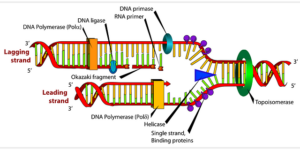Bacteria are one of the large groups of free living prokaryotic microorganisms. They possess a prokaryotic kind of cellular structure. Here we will try to find the answer of do bacteria have DNA and do bacteria have ribosomes.
All bacterial cells have DNA or deoxyribonucleic acid in their cytoplasm as their genetic material.
The bacterial DNA structure is slightly different from eukaryotic DNA molecular structure.The bacteria also have ribosomes in their cytoplasm as the protein factory of their cell.
Do bacteria have DNA?
DNA is the main genetic meterial in all living beings. It pases genetic information from generations to generation.
Bacteria have DNA. Bacterial cells have a naked circular single DNA chromosome in its cytoplasm. This is the genetic material of that organism.
In addition to this bacterial cells also have an extrachromosomal DNA, called plasmid DNA in their cytoplasm. This Extrachromosomal DNA provides some genetic advantages to that organism.

Bacterial DNA from pixabay
What is DNA?
The word DNA stands for deoxyribonucleic acid. It is composed of polynucleotide chains.
DNA carry genetic information in an organism. It consists of a deoxyribose sugar molecule, nitrogen containing nucleobases and a phosphate group.
All organisms such as archaea or bacteria have circular single chromosomal DNA in their cytoplasm.
What are the components of DNA?
The two polynucleotide chains coil to form the DNA double helix. The polynucleotide chains are antiparallel and made up of monomeric nucleotides.
Deoxyribonucleic acid or DNA made up of a deoxyribose sugar molecule, nitrogen containing nucleobases and a phosphate group.
The nucleotides have one of the four major nucleobases that are purines such as adenine (A) and guanine (G), pyrimidin such as thymine (T) and cytosine (C). The nucleotides are binds with each other by phospho-diester linkage bonds between a sugar of one nucleotide and phosphate of another. The nitrogenous bases (Adenine with thymine and guanine with cytocine) of two polynucleotide chains bound together with hydrogen bonds. According to basepairing rules one purine and one pyriimydin joins with hydrogen bonds. Adenine pairs with thymine with hydrogenous double bond and guanine pairs with cytocine with hydrogenous triple bonds. The two polynucleotide strands carries same genetic informations.
What is genomic DNA in bacteria?
The genomic DNA or chromosomal DNA of bacteria is the main genetic material of that organism. It carries almost all the genetic instructions in it.
The genomic DNA or chromosomal DNA is a naked ( not bound with any kind of proteins) circular double stranded DNA. It is continuous, which means it has no free ends (telomere).
It doesn’t have any histon protein. The genomic DNA is larger in size than the plasmid DNA. It’s size varies from about 130 kbp to over 14 Mbp. It encodes all the genetic instructions related to growth, development and reproduction. It can be transferred through the cell division process.
What is plasmid DNA in bacteria?
Distinct from chromosomal DNA bacterial cells have another kind of extrachromosomal DNA that is plasmid DNA in their cytoplasm.
This special kind of DNA material provides that organism some special genetic advantages like antibiotic resistance.The plasmid DNA is smaller than the chromosomal DNA in size from 1 to over 200 kbp. The number of plasmid DNA in a single cell varies from 1 to 1000.
It carries some additional genes which encodes genetic information that is genetically beneficial to those organisms and helps in their survival (antibiotic resistance). Plasmid DNA has its own origin of replication, which means It can replicate independently. It is transferred only by the horizontal gene transfer.
Do all bacteria have DNA?
Yes, all bacteria have DNA as their genetic material.
They have different forms like chromosomal DNA, mitochondrial DNA, plasmid DNA, etc.
Why do bacteria need DNA?
All living organisms including bacteria all need DNA in their cells. As a genetic material the significance of DNA or deoxyribonucleic acid in an organism is immense.
- DNA or deoxyribonucleic acid is the carrier of all the genes in a cell. That means it carries all the genetic instructions in it.
- The genetic codes in DNA responsible for making every required protein molecule in cells.
- Through the replication process the DNA makes identical copies of itself and transfers. It carries all the genetic instructions from generation to generation.
- DNA acts as a template for the RNA synthesis process.
- The DNA is responsible for every biological activity within the cell ( directly or indirectly).
- DNA is also responsible for cell aging or cell death.
To know more about Bacterial DNA Replication check out this article Bacterial DNA Replication Steps.

DNA replication from pixabay
How much DNA does bacteria have?
As we already discussed, all bacteria have DNA. The amount of DNA varies from species to species.
For example, the amount of chromosomal DNA in Mycoplasma genitalium ranges about 580,000 base pairs.
In Escherichia coli the amount is about 4,700,000 base pairs and in case of Myxococcus xanthus it ranges about 9,450,000 base pairs.
What is DNA polymerase?
DNA polymerase is a class of enzymes necessary for replication of DNA.
DNA polymerase catalyzes the chemical reaction of the replication process. During cell division it reads the template DNA strand, creates identical copies of it by adding nucleotides and completes the replication process with the help of other groups of enzymes. It also performs some DNA repair mechanisms.
How many DNA polymerases do bacteria have?
Bacterial cells have three DNA polymerase enzymes which are extremely important in DNA replication and DNA repair processes.
- DNA polymerase I : In 1956 DNA pol l was first discovered by Arthur Kornberg. It is one of the main enzymes for the bacterial replication process. It is encoded by the gene called polA. It also supports DNA repair mechanisms. It makes short DNA stretches, replacing that with RNA primers during excision repair mechanism. It also helps to join okazaki fragments in the lagging strand. The DNA pol l can add about 15 to 20 nucleotides per second.
- DNA polymerase II : In 1970 Thomas Kornberg isolated a DNA polymerase enzyme belonging to the B family of DNA polymerase, called DNA pol ll. It is encoded by the gene called polB. It has both endonuclease and exonuclease capabilities. It can synthesize DNA from both the directions. It also performs primase activities. The DNA pol ii is very important for DNA proofreading mechanisms.
- DNA polymerase lll : In 1970 DNA pol iii was discovered by Thomas Kornberg and Malcolm Gefter. It is the primary holoenzyme complex for the bacterial DNA replication process. It plays a major role in synthesis of daughter DNA strands. It can add about per second. It has endonuclease and exonuclease capabilities. It can also possess a proofreading mechanism. It has the highest polymerization rate that means it can add about approximately 1000 nucleotides per second.
How many genes does a bacteria have?
The number of genes in a bacterial cell varies in different species.
According to a study, parasitic bacteria may have 500–1200 genes, free-living bacteria have 1500–7500 genes, and archaea have 1500–2700 genes in their genome.
In Escherichia.coli bacteria 4288 annotated protein coding genes, seven rRNA operons, 86 tRNA genes can be found.
Do bacteria have ribosomes?
Yes, bacteria cells have ribosomes in their cytoplasm. The bacterial cell is composed of 70S ribosomes which have the smaller subunit 30S and larger subunit 50S.
The bacterial ribosomes are about 200 nm in diameter. It is a nucleoprotein present in cytoplasm which helps in protein synthesis.
What are ribosomes?
In 1950 the famous Romanion-Americn cell biologist Gourge Emil Palade first discovered ribosomes.
Ribosomes are protein molecules present in cytoplasm. It mainly helps in mRNA translation and protein synthesis process. As it plays a major role in translation ,the ribosomes and its associated molecules are known as translation apparatus.
Ribosomes are composed of two different molecules, that is ribosomal RNA (rRNA) and protein molecules. Ribosomes have two different subunits. In the case of eukaryotic cells, the 80S ribosome has the small subunit 40S and the large subunit 60S. In the case of a prokaryotic cell the ribosome is 70S ribosome, which comprises 30S and 50S subunits. Where the S stands for a unit of density that is the Svedberg unit.
Where are the ribosomes found?
The ribosomes are found in two different forms, it can be free or it can be attached with an endoplasmic reticulum.
In case of prokaryotic organisms the ribosomes are present only in free form within the cytoplasm.
In case of eukaryotic cells the ribosomes are found in both forms. It can be present in cytoplasm as a free molecule and also present with the endoplasmic reticulum.
What are the functions of ribosomes?
- Translation: The ribosome plays the main role in the translation process. The ribosomes decode the message from the m-RNA and by adding proper amino acids with the help of t-RNA synthesizes a protein molecule required to the cell.
- Cotranslational folding: Ribosomes play a major role in cotranslational modifications of protein molecules. It has protein folding activities in it.
- Addition of translation independent protein molecules.
As a whole we can say that bacterial cells possess DNA as their genetic material and ribosomes as protein synthesizers of their cell. Here we briefly describe all possible aspects of it. We try to give a clear idea about do bacteria have DNA? describe the features and functions of it. We also discuss about bacterial ribosomes, their features and some important functions. Hope this article will be helpful to you.
Also Read:
- Genome example
- Does mitosis occur in plant cells
- Amino acids in cytoplasm
- Host plant examples
- Is fatty acid polar
- Gram negative bacteria examples
- Carbohydrates polymer examples
- Are protists aquatic
- Creeper plant example
- Do prokaryotes have trna

Hello, I am Piyali Das, pursuing my Post Graduation in Zoology from Calcutta University. I am very passionate on Academic Article writing. My aim is to explain complex things in simple way through my writings for the readers.